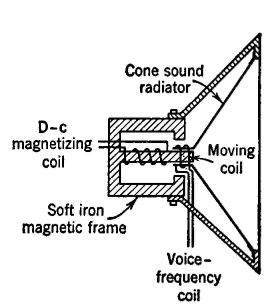| Electrical Communication is a free textbook on the basics of communication technology. See the editorial for more information.... |

|

Home  Electroacoustic Devices Electroacoustic Devices  Moving-Coil (Electrodynamic or Dynamic) Motor Element Moving-Coil (Electrodynamic or Dynamic) Motor Element |
|||






|
|||
Moving-Coil (Electrodynamic or Dynamic) Motor ElementThis motor element is used almost universally in loudspeakers. A cross section of a dynamic loudspeaker using such a motor element is shown in Fig. 19. It has been pointed out28 that a loudspeaker of this type was invented by Lodge in 1898.
The moving-coil motor element consists of a voice coil of a few turns of wire suspended in a very strong, constant magnetic field. The coil is free to move back and forth axially. It is attached to a suitable acoustic radiator, such as a paper cone as in the radio dynamic loudspeaker, or a metal diaphragm, as in the driving unit used with large horn-type loudspeakers. The signal current variations in the voice coil react with the constant magnetic field and cause the coil and acoustic radiator to move and radiate sounds. The strong constant magnetic field is produced by an electromagnet as shown in Fig. 19, or by a permanent magnet. If an electromagnet produces the field, the coil is sometimes made of a few turns of fairly heavy wire, and the direct current is furnished by a storage battery or by rectifiers. Or the coil can be made of a large number of turns of fine wire, and the exciting current is furnished by a rectifier supplying, perhaps, 50 milliamperes at several hundred volts. In many radio receiving sets the loudspeaker field coil also serves as the inductor, or "choke," in the filter of the power supply. The impedance of the voice coil in a moving-coil driving unit is very low, a typical value being Z = 8.8/+25° ohms at 1000 cycles, and a direct-current resistance of 5 ohms. Many moving-coil loudspeakers have an impedance-matching transformer (page 68) mounted on them to increase their impedance so that they will match amplifiers with high-impedance outputs. When the impedance of the voice coil was measured through an inexpensive transformer of this type, it was found to be Z = 2400/+30° ohms. The difference in these phase angles is caused largely by the transformer. As mentioned earlier in this section, the moving coil of a motor element used to drive a large horn is connected to a small metal diaphragm. A motor element of this type is shown in Fig. 20. The design of the diaphragm, air chamber, throat, and other details of a moving-coil motor element of this type is a specialized subject of much importance.
|
|||
Home  Electroacoustic Devices Electroacoustic Devices  Moving-Coil (Electrodynamic or Dynamic) Motor Element Moving-Coil (Electrodynamic or Dynamic) Motor Element |
|||
Last Update: 2011-05-18


